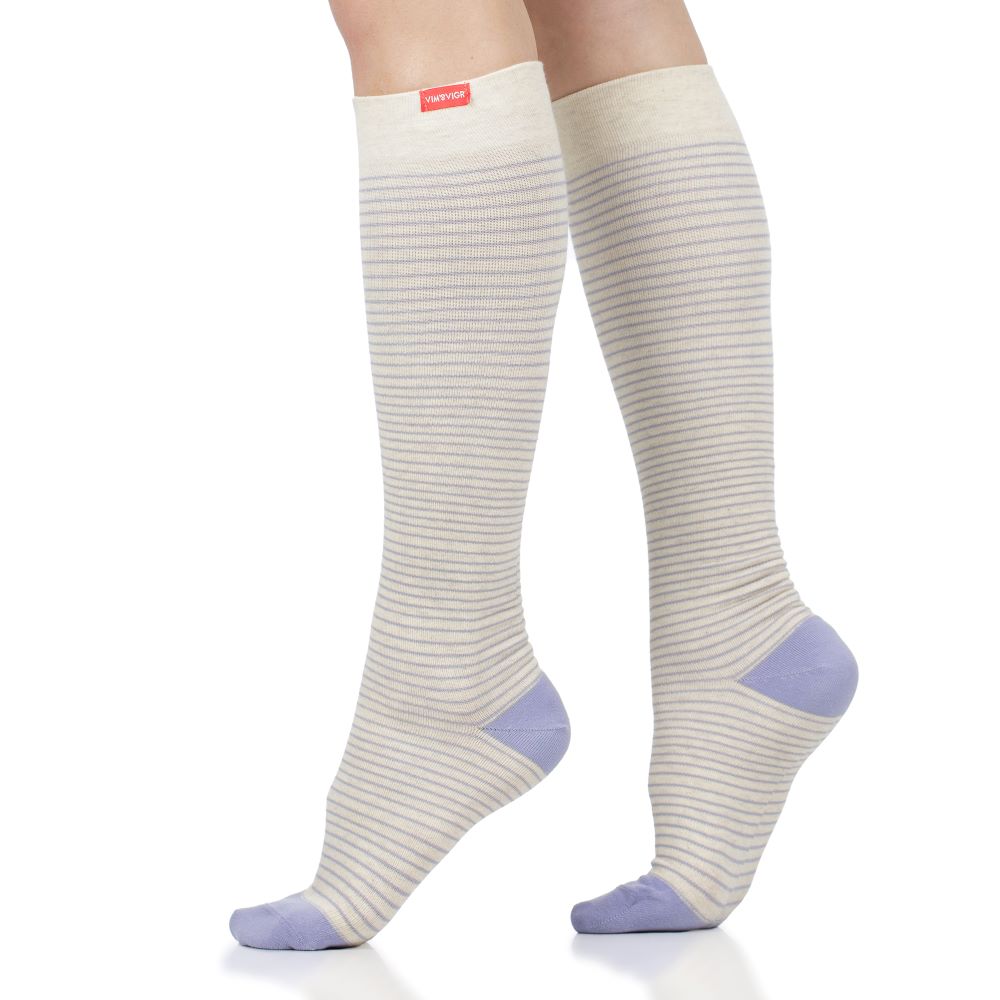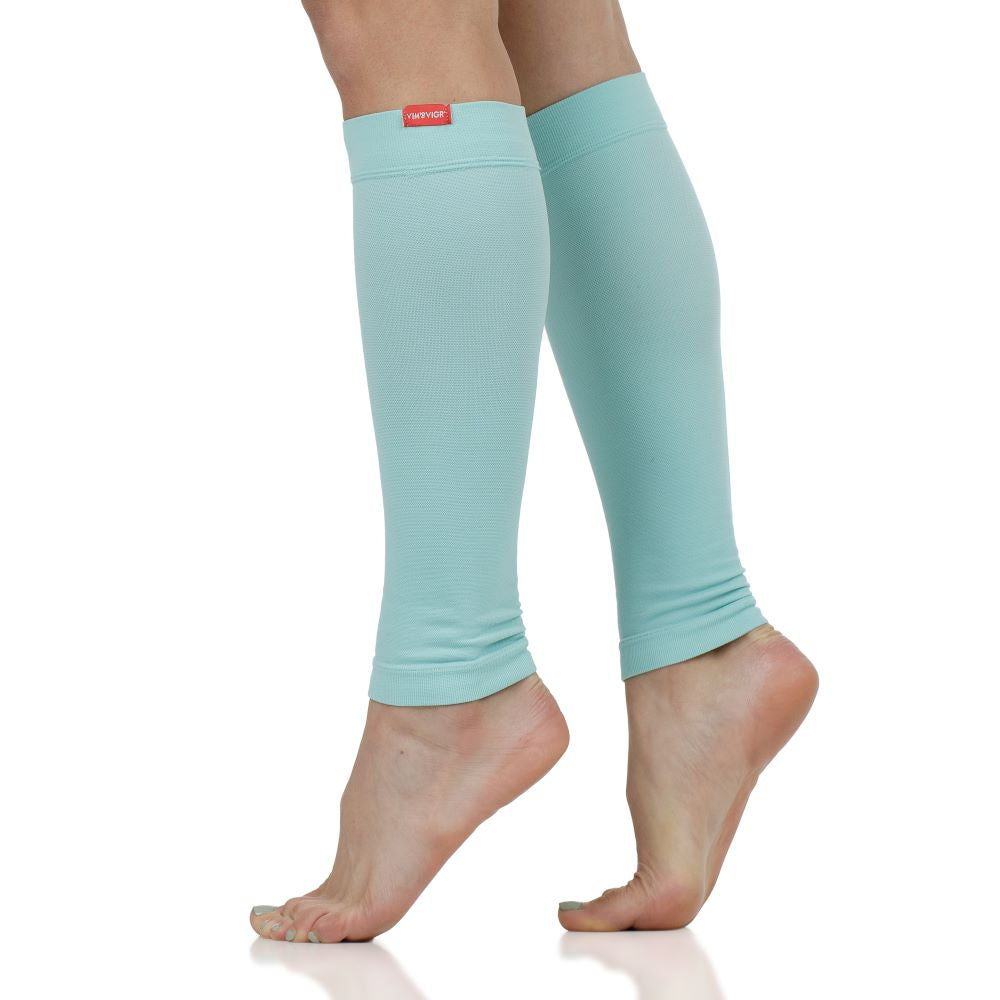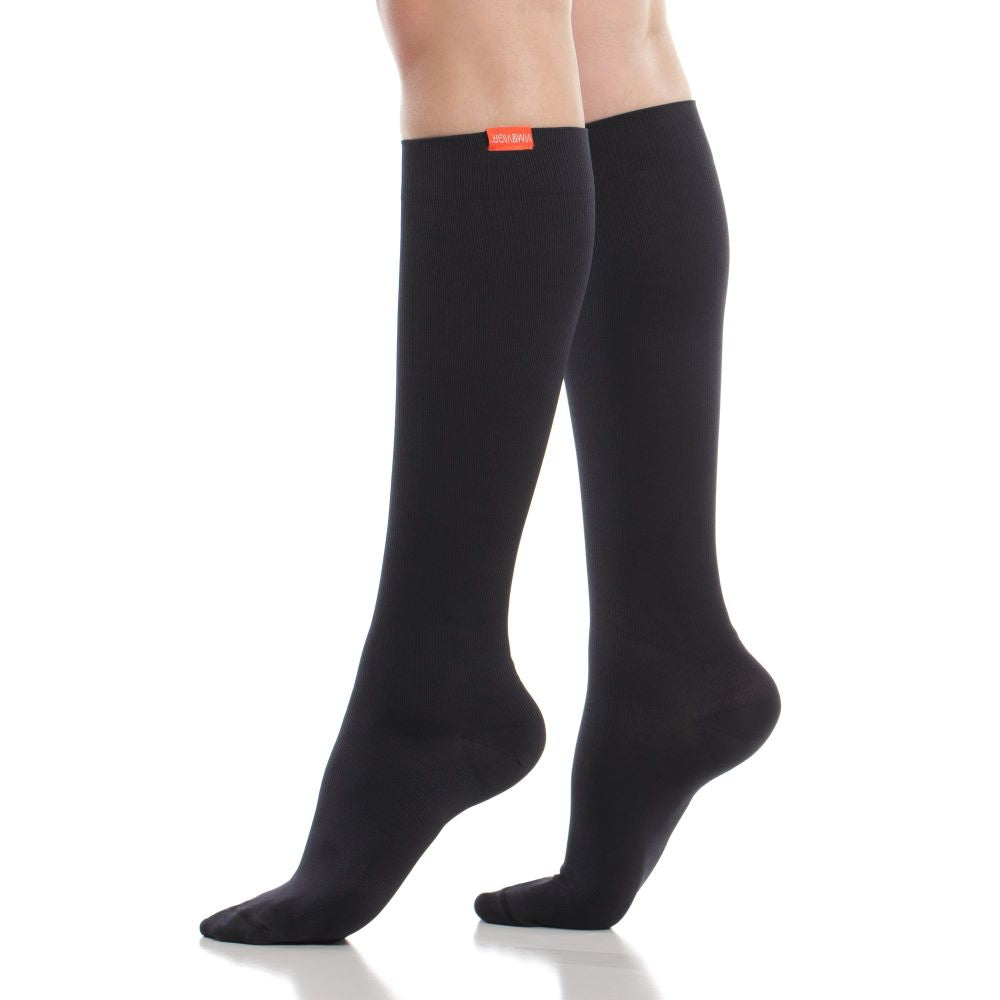Lipedema vs Lymphedema: What's the Difference?
There are many misunderstandings about the difference between lipedema and lymphedema since both can cause swelling of the legs. While technically, they both are edemas, also known as swelling, the cause of the edema is not the same.
What is the difference between lipedema and lymphedema? And is there a relationship between these two conditions? The clue is in the name: “lip-” refers to fat (from the Greek lipos), while “lymph-” refers to liquid (from the Latin lympha, meaning clear water).
This clue should show you a major difference between the two, as we will see in this article. Read on to find out the details on each side and look at how to address them.
What’s the Main Difference Between Lipedema and Lymphedema?
These two conditions have different causes and slightly different manifestations. Lipedema occurs when excessive fat deposits appear in the legs and sometimes the arms. Swelling with lipedema is generally non-pitting - there is no dimple left when the skin is prodded. By contrast, lymphedema is caused by poor lymphatic drainage, often triggered by problems with the lymph nodes, according to the NIH. Unlike lipedema, the skin will dimple when prodded in people with lymphedema.
Additionally, lipedema doesn’t affect the hands and feet, but lymphedema does. Finally, it’s rare to have skin infections when suffering from lipedema. In contrast, people with lymphedema often suffer from skin infections like cellulitis, according to the Mayo Clinic.
What is Lipedema?
Lipedema is the term used to describe an adipose tissue disorder where there is excessive build-up of fat in the legs (and, less commonly, on the arms). According to a recent research report, lipedema may affect nearly 11% of women worldwide. One common misconception about lipedema is that it is caused by lifestyle or diet, but that is not true. So, what causes lipedema? There is much debate about the root cause of lipedema, but lipedema is likely caused by abnormally high fat cell growth.
Lipedema usually appears equally on both sides and can become uncomfortable, even painful. While for some people, the symptoms are negligible, others can be faced with serious physical problems (often in relation to how serious the condition is and whether it’s linked to another health issue).

What is Lymphedema?
Lymphedema refers to swelling caused by excess lymph, which is protein-rich fluid that is normally drained out of the body by the lymphatic system. Like lipedema, lymphedema also occurs most often in the arms or legs. Lymphedema is very common in cancer patients because cancer treatments can damage the lymph nodes. Lymphedema can cause difficulty of movement, increase the risk of infections, and other serious issues.
Lipedema vs Lymphedema: Let’s Compare
We’ve established that these two conditions are separated by the root cause - the swelling produced by either abnormal fat accumulation (lipedema) or by poor lymphatic fluid drainage (lymphedema). Let’s look at a few details about the differences in how lipedema and lymphedema can start.
Lipedema vs Lymphedema: Pathophysiology
Currently, the pathophysiology of lipedema remains unclear, according to a 2020 research review. Lipedema occurs because of abnormal quantities of fat accumulating under the skin, but this isn’t necessarily caused by obesity or a poor diet. In fact, some Stanford Medicine has reported that there may be a link between lipedema and lymphedema - there appear to be biomarkers connecting the two.
Many questions persist as to the way lipedema sets in and even its mechanisms – from whether it is a lymphatic disease to what causes pain associated with lipedema.
On the other hand, more is known about lymphedema and its causes. When the lymphatic system fails to flush lymph into the circulatory system, it is likely caused by damage to the lymph nodes. Lymph node damage has been linked to cancer cells blocking lymph vessels, anti-cancer radiation scarring or inflaming the lymph nodes, removal of lymph nodes through surgery, and some parasites infecting them.
Lipedema vs Lymphedema: Symptoms
People who suffer from lipedema (very often, women, after particular hormonal changes like post-pregnancy or menopause) may start off by noticing bigger-looking legs, by comparison to a smaller waist and upper body. The feet are not usually affected by the swelling. Similarly, if the deposit of fat affects the arms, hands are usually unaffected. Skin often has a “orange peel” texture and starts to feel soft and cool.
Lymphedema also manifests through swelling, particularly in the arms and legs. Importantly, lymphedema patients’ fingers and toes are also affected, unlike in the case of lipedema. In time, the swelling restricts your range of motion, can make it difficult to walk, and cause significant pain. The skin may harden and thicken, unlike for lipedema patients where skin is soft. Cellulitis is a common concern in patients with lymphedema, according to the NIH. Cellulitis may be a life-threatening infection of the skin by bacteria. Because skin in swollen areas is thin, bacteria can more easily enter fluid-rich areas. If you suffer from lymphedema, keep an eye out for symptoms of cellulitis like:
- Tenderness, rash-like redness, and pain in swollen areas
- Warmness in swollen areas
It’s important to keep in mind that the symptoms of both lymphedema and lipedema can vary widely from patient to patient. In cases of lymphedema caused by cancer treatment, symptoms may not occur until months or even years later.
Discover compression stockings to help support heavy legs.
Lipedema vs Lymphedema: Fat Distribution
In lipedema patients, the fat deposit is generally found on the legs, making the person’s bottom and thighs look disproportionately larger when compared to the rest of their body. In time, more severe lipedema will spread to the lower legs and sometimes the arms. As mentioned above, hands and feet are usually unaffected.
By contrast, lymphedema patients suffer from swelling in part of or the whole arms or legs, also including fingers and toes. Importantly, the swelling isn’t caused by fat, but by lymphatic fluid buildup.
Lipedema vs Lymphedema: Causes and Risk Factors
It’s still unclear what the causes of lipedema are. It has often been associated, mistakenly, with obesity, but people with a healthy lifestyle could still develop symptoms of lipedema. Most often, hormonal changes in women seem to be the common trigger (including puberty, pregnancy, menopause, or a reaction to hormonal contraception), according to a scientific review published in the International Journal of Molecular Sciences.
Unlike lipedema, the most common causes of lymphedema include:
- Cancer cells blocking lymph vessels
- Cancer treatment – particularly radiation – damaging lymph nodes
- Cancer surgery leading to removal of lymph nodes
- Infection from certain parasites in tropical countries, which leads to clogging the lymph nodes
Older people are more at risk of developing lymphedema, as well as those who are overweight or obese.
Diagnosis
If you notice persistent swelling in your arms or legs, you should consult a healthcare provider to test for either lipedema or lymphedema. In both cases, you should expect to undergo some tests such as:
- MRI scan
- CT scan
- Ultrasound
If you’ve recently undergone cancer treatment and the symptoms match, that can be sufficient for a doctor to diagnose you with lymphedema. In the case of lipedema, however, more tests may be needed.
Progression
Both lipedema and lymphedema can evolve into painful and uncomfortable stages if left untreated. For lipedema, patients may start seeing the increased size of the affected legs or arms and develop pain and bruising at early stages. This can evolve into the skin surface becoming uneven and dimpling. In advanced stages, people find it difficult to walk because of skin folding over and the fat on the legs sticking out.
In cases of lymphedema, the disease may start with some simple feelings of tingling or heaviness. This can go on for years before major symptoms occur. As lymph starts to accumulate, there is swelling and possibly small dents in the skin when it is pressed, but no permanent damage. When you elevate your legs or arms, the swelling goes down. In later stages, the swelling does not decrease with elevation, the tissue under the skin becomes inflamed or thickened, and the affected area becomes seriously enlarged or misshapen.
Treatment Options and Management Strategies
There are no cures for either lipedema or lymphedema. The latter increases the risk of skin infections like cellulitis – so you may benefit from antibiotics if cellulitis symptoms appear.
In both cases, exercise may be able to improve symptoms. Swimming, biking, or walking can bring down the swelling and increase mobility without causing too much impact on your joints. Lipedema patients may also benefit from an anti-inflammatory and heart-healthy diet, which can slow down its progression (but won’t lead to “losing fat” like in a weight-loss program, since lipedema fat is different from fat caused by lifestyle or diet choices).
Lipedema and lymphedema are both characterized by swelling which can become painful. In both cases, wearing compression socks, stockings, or tights can help manage painful swelling. Compression can encourage lymphatic drainage for lymphedema sufferers. It also offers additional support for the legs, making exercising possibly less painful and/or uncomfortable.
Some patients suffering from lymphedema can use pneumatic compression – where an inflatable sleeve is worn around the affected limb and then is inflated, putting calculated pressure on the affected limb with the intention of moving lymphatic fluid.
There are also some invasive therapies that may help. In the case of lipedema, it is possible that you may find relief through liposuction. For lymphedema patients, doctors can prescribe lymph node transplants or create new drainage paths through surgery. All of these should be discussed carefully with your healthcare provider.
Can Lipedema Turn Into Lymphedema?
Some studies point to a connection between lymphatic diseases and lipedema, suggesting that lipedema could be caused by issues with the lymphatic system. However, what we do know is the opposite – lipedema, through the added storage of fat deposits in the body, can lead to disrupting fluid transport in the limbs. This can mean an increased risk of lymphatic swelling or lymphedema, according to a scientific study. .
Is Lymphedema More Serious Than Lipedema?
Both lymphedema and lipedema are serious in their own way and can lead to debilitating symptoms for those suffering from these conditions. Since lymphedema can be asymmetric, it can be tempting to consider it less serious as it will only affect one limb in this scenario. But this isn’t always the case.
Similarly, as lipedema spares the hands and feet, it can be considered less uncomfortable and easier to manage than lymphedema. Ultimately, both can severely restrict mobility, cause pain and discomfort, and lead to other conditions and illnesses.
Can Lipedema and Lymphedema Be Cured?
There is no known cure for lipedema. It can only be managed with movement, looking after the skin to prevent it from drying out, and wearing compression garments that reduce the pain and discomfort, while also supporting the limbs.
There is also, sadly, no cure for lymphedema. Minimizing fluid build-up will reduce symptoms, as will stimulating lymphatic flow throughout the body. An accessible way to do this can be by wearing graduated compression tights or stockings, which also support the limbs during movement and exercise.
References
National Institute of Health. Lymphedema and Cancer Treatment – Side Effects. (2015). National Cancer Institute; Cancer.gov. Read it here.
Mayo Clinic. (2022). Lymphedema – Symptoms and causes. Mayo Clinic. Read it here.
Buck, D. W., 2nd, & Herbst, K. L. (2016). Lipedema: A Relatively Common Disease with Extremely Common Misconceptions. Plastic and reconstructive surgery. Global open, 4(9), e1043. Read it here.
Kruppa, P., Georgiou, I., Biermann, N., Prantl, L., Klein-Weigel, P., & Ghods, M. (2020). Lipedema-Pathogenesis, Diagnosis, and Treatment Options. Deutsches Arzteblatt international, 117(22-23), 396–403. Read it here.
White, T. (2020). Biomarker for lipedema, other lymphatic diseases discovered. Stanford Medicine News Center. Read it here.
Katzer, K., Hill, J. L., McIver, K. B., & Foster, M. T. (2021). Lipedema and the Potential Role of Estrogen in Excessive Adipose Tissue Accumulation. International journal of molecular sciences, 22(21), 11720. Read it here.
Ma, W., Gil, H. J., Escobedo, N., Benito-Martín, A., Ximénez-Embún, P., Muñoz, J., Peinado, H., Rockson, S. G., & Oliver, G. (2020). Platelet factor 4 is a biomarker for lymphatic-promoted disorders. JCI insight, 5(13), e135109. Read it here.
Pereira de Godoy, L. M., Pereira de Godoy, H. J., Pereira de Godoy Capeletto, P., Guerreiro Godoy, M. F., & Pereira de Godoy, J. M. (2020). Lipedema and the Evolution to Lymphedema With the Progression of Obesity. Cureus, 12(12), e11854. Read it here.



















Leave a comment